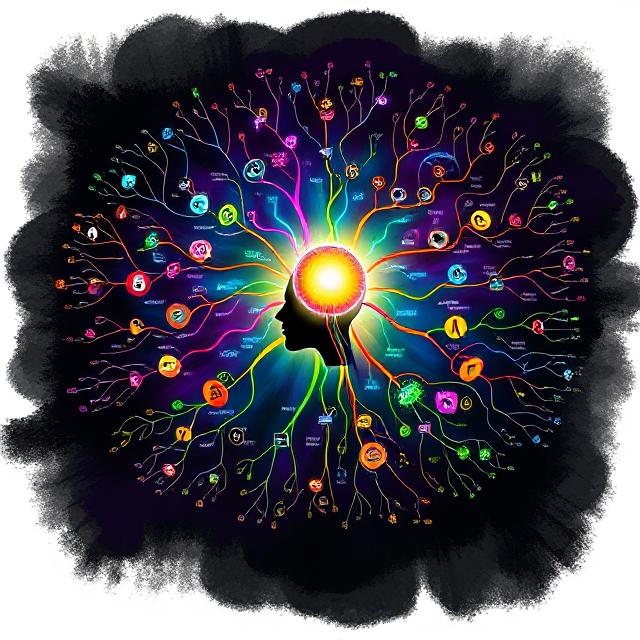Table of Contents
Syntopic Learning: The Discipline of Connecting Ideas
Most learning systems ask you to consume.
Syntopic learning asks you to compare, challenge, and synthesize.
It’s not about memorizing definitions—it’s about forming meaningful relationships between ideas, across time, context, and source.
At its core, syntopic learning trains you to see the structure behind the content, activating deeper brain circuits for understanding, retention, and long-term mental growth.
What Is Syntopic Learning?
Syntopic learning is the method of studying multiple perspectives simultaneously, focusing on how they relate and contrast rather than learning them in isolation.
It’s the opposite of monolithic learning (rote memorization, single-source instruction).
Instead, it’s built on:
- Comparison → spotting where ideas align or diverge
- Contextualization → understanding when/why ideas evolved
- Integration → blending sources into your own mental model
This approach uses high-level neural integration, activating prefrontal synthesis, long-term memory storage, and pattern recognition centers—especially when combined with rhythm-based study techniques.
Why It Works: The Brain Science Behind It
Syntopic learning engages multiple brainwave states:
| Brainwave | Role in Syntopic Learning |
|---|---|
| Alpha | Creates calm, absorbent mental state |
| Theta | Facilitates connections between unrelated ideas |
| Gamma | Synthesizes high-level insights across domains |
It also mimics the brain’s natural integrative behavior—our minds learn best when they compare stories, see contradictions, and restructure old ideas with new information.
Real-World Applications
Academic Learning
- Compare theories in psychology (e.g. behaviorism vs. constructivism)
- Study philosophical models across cultures (Eastern vs. Western ethics)
- Analyze different interpretations of a historical event
Creative Work
- Blend writing styles from authors across time
- Combine color theory, sound design, and spatial rhythm in art projects
Problem Solving
- Use biology, engineering, and physics to model sustainable design
- Leverage economics + psychology to understand consumer behavior
Syntopic learners aren’t just informed—they’re adaptable thinkers.
How to Practice Syntopic Learning
1. Choose a Central Question
Start with a powerful question—not just a topic.
Example: What causes lasting behavior change?
2. Gather Sources
Use 3–5 sources across disciplines or eras:
- A book from psychology
- A philosophical essay
- A neuroscience paper
- A historical case study
3. Compare Arguments
Ask:
- Where do they agree?
- Where do they conflict?
- What assumptions does each make?
4. Map the Synthesis
Use tools like:
- Venn diagrams
- Idea matrices
- Concept bridges
- Mind maps
5. Write Your Summary
The final product should not copy any single view.
It should reflect your own framework, formed through the interplay of others.
✍️ Example: Syntopic Study on Memory
Question: What is memory?
| Source | View |
|---|---|
| Cognitive Psychology Textbook | Memory is an encoding–retrieval system (short-term → long-term) |
| Buddhist Meditation Manuals | Memory is a mental impression formed by attention and emotion |
| Neuroscience Article | Memory is synaptic plasticity involving the hippocampus |
| Personal Journal | Memory feels linked to the senses and strong emotional anchors |
Synthesis: Memory is not just storage—it is emotionally filtered, pattern-seeking recollection, shaped by both biology and attention rituals.
Tools to Support You
Grab our Syntopic Learning Kit from the Tools & Trackers section:
- Printable Synthesis Map Template
- Multi-Source Comparison Grid
- Syntopic Journal Pages
- 30-Day Challenge Calendar for Syntopic Habit Building
When to Use Syntopic Learning
| Goal | Best Brain State | Study Timing Tip |
|---|---|---|
| Idea generation | Theta | Mid-morning or early evening |
| Concept comparison | Alpha | Quiet block after light physical movement |
| Integration writing | Gamma | Use ambient sound + no interruptions |
Combine this with a focus ritual (see: Cognitive Flow & Focus Hacks) for best results.
Free Download
Syntopic Study Map Template (PDF)
Includes:
- 3-column idea bridge
- Argument tracking fields
- Synthesis prompt worksheet
Final Thought
Syntopic learning is how wisdom is formed—not just knowledge.
When you link ideas, contrast perspectives, and train your brain to hold complexity, you’re not just studying.
You’re becoming a systems-level thinker.
Start connecting what others keep apart.
Let rhythm, structure, and contrast guide your learning.










